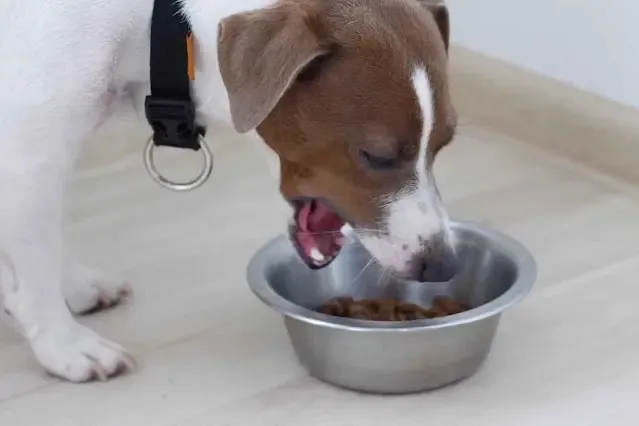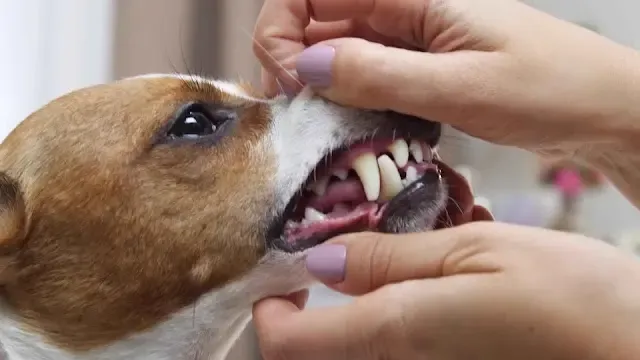How much do I feed my dog a day?
The amount of food your dog needs will depend on his breed, size, age, and activity level. An easy way to determine how much to feed is to use the guidelines provided by the Association of American Feed Control Officials (AAFCO).
They recommend that adult dogs receive between 5 and 8 percent of their body weight in food each day.
 |
| Do and don'ts | Dog Feeding Guide, How to Feed a Dog |
Do and don'ts of feeding dogs?
When it comes to feeding your dog, it is important to follow a few guidelines. Make sure you feed them a well-balanced diet designed specifically for their breed and size. Provide them with clean and fresh water every day.
Do not overdo it as this may lead to obesity and other health problems. Avoid giving them any foods high in sugar or fat as they may cause digestive problems.
It is also important to feed your dog at the same time each day to ensure that he is getting adequate nutrition. We will explain everything in detail below and answer all your questions about feeding your dog.
Today in this article we are going to talk about a basic feeding guide for your dogs, how to feed them and how to keep them hydrated. You will learn all about dog food.
As we all know that dogs' teeth are made for a meat-based diet, their teeth are not built for grinding food, so the best source of protein is animal protein. So let’s have a look at what should be given and what should be not.
Is it OK to feed your dog once a day?
It is not recommended to feed your dog only once a day. Dogs need regular, consistent nutrition throughout the day in order to stay healthy and strong.
Ideally, you should feed them twice a day with portions based on their breed, size, age, and activity level. If you are only able to feed your dog once per day, split their total daily portion into two meals.
 |
| Do and don'ts | Dog Feeding Guide, How to Feed a Dog |
If you feed your dog twice a day, it's important to provide them with two meals that contain the same amount for each meal.
Additionally, make sure these meals are spread out throughout the day so that their energy levels stay consistent. Avoid feeding them just before or after an intense exercise session as this can cause digestive issues.
Furthermore, try to avoid feeding them human food as much as possible, as it is not always nutritionally balanced for dogs.
how to feed a dog with no teeth?
If your dog has no teeth, they will still be able to eat. It is important to feed them a diet that is soft and easily digestible, such as canned food or ground-up kibble.
You can also give them treats such as boiled chicken, scrambled eggs, and applesauce. Make sure to also provide them with plenty of fluids, as toothless dogs can be prone to dehydration. Speak with your veterinarian about the best type of food for your dog's needs.
It is important to pay special attention to your toothless dog's diet. If you are giving them canned or ground-up food, make sure they are getting all the necessary vitamins and minerals.
Speak with your veterinarian about supplementing their diet with multivitamins or adding wet food to their kibble. Additionally, make sure to feed them several times a day, as your dog may not be able to consume large meals at once.
How do i feed my dog toothless in practice
In practice, start by speaking with your veterinarian about the best diet and food for your toothless dog. Soft canned food and ground-up kibble are great options for toothless dogs as they are easy to consume.
Be sure to feed your dog several times throughout the day in order to keep their energy levels consistent.
You can also offer them treats such as boiled chicken, applesauce, and scrambled eggs. Additionally, make sure your dog has access to plenty of clean, fresh water.
how to feed a dog medicine?
When feeding your dog medicine, it is best to mix it with a treat or a small amount of their regular food to disguise the taste and make it easier for them to eat.
Always consult a veterinarian before giving any kind of medication to your pet to ensure that it is safe and the proper dosage is used.
Additionally, always monitor your pet while they take the medication and make sure they have swallowed the entire dose.
 |
| Do and don'ts | Dog Feeding Guide, How to Feed a Dog |
For tablets, it is usually recommended to crush them in a powder form before adding them to the food or treat.
If the medication you are giving your dog is a liquid, make sure to mix it in with their food or treat so that they do not taste the medication itself.
If you are feeding your dog a pill or capsule, it is important to make sure that they swallow the entire pill or capsule instead of just biting into it. To ensure this, it is best to use a pill pocket or wrap the pill or capsule in a piece of soft cheese or pieces of meat.
Additionally, always monitor your pet while they take the medication and make sure they have swallowed the entire dose.
How do I calculate how much food my dog needs?
To calculate how much food your dog needs, there are a few different factors to take into account. This includes the size and age of your dog as well as their activity level.
It is best to consult your veterinarian to determine the exact amount of food your dog needs per day, as this will depend on their specific breed and lifestyle.
Generally, smaller dogs need less food than larger dogs and puppies need more food than adult dogs. Additionally, highly active dogs may need more food than those that are more sedentary.
Additionally, it is important to always read the instructions that come with your dog food as different brands may have different nutritional guidelines for dogs of different sizes and ages.
When determining the amount of food to feed your pup, start by measuring out a portion of the suggested serving size and adjust accordingly depending on how your dog responds.
Monitor their weight regularly and adjust the portion sizes as needed to ensure they are getting the right amount of nutrition. If you notice any signs of malnourishment or obesity in your pet, contact your veterinarian immediately.
is it cruel to feed a dog once a day?
That depends on the size, breed, and age of the dog. Generally speaking, most dogs need two meals a day to maintain their health.
If you feed them once a day, it is important to make sure that the portion size and nutritional content are adequate for their size, breed, and age.
 |
| Do and don'ts | Dog Feeding Guide, How to Feed a Dog |
Most dog owners feed their dogs two meals a day: one in the morning and one in the evening. The recommended portion size for each meal will vary depending on the size, breed, and age of the dog. Puppies need more frequent meals than adult dogs, as they are still growing.
Senior dogs should have smaller meals throughout the day. It is important to ensure that the meals are balanced with the correct amount of protein, carbohydrates, and healthy fats.
If you are feeding your dog once a day, it is important to make sure that the meal contains all of the essential nutrients they need and is tailored to their individual needs.
best time to feed dog
The best time to feed your dog will depend on their individual schedule, as well as their preferences. Generally speaking, most dogs prefer to eat twice a day - once in the morning and once in the evening.
This allows them to have more consistent energy levels throughout the day, as well as regular opportunities for potty breaks. It is important to provide food at the same times each day in order to establish a routine for your pup.
Establishing a consistent feeding schedule is important for your pup’s health and wellbeing. Keeping the same meal times each day helps to regulate their digestive system, allowing for regular potty breaks.
When establishing a feeding schedule, it is important to consider their individual needs such as age, breed, size, and activity level.
For puppies and senior dogs, more frequent meals may be necessary. Smaller meal sizes are best for puppies and senior dogs, as they are less likely to over eat.
It is also important to ensure that the meals contain the correct balance of proteins, carbohydrates, and healthy fats for your pup's nutritional needs.
dog feeding schedule by age
The frequency and portion size of a dog’s meals should be tailored to their individual age. Puppies, for example, require more frequent meals throughout the day, as they are still growing. Smaller meal sizes are best for puppies and senior dogs, as they are less likely to overeat.
Adult dogs typically require two meals a day: one in the morning and one in the evening. The recommended amount will vary depending on the size, breed, and activity level of the dog.
 |
| Do and don'ts | Dog Feeding Guide, How to Feed a Dog |
When creating a feeding schedule for your dog, it is important to consider his individual needs. For puppies and large dogs, frequent feeding may be necessary.
Puppies require more frequent meals throughout the day to support their growth, while larger dogs should eat smaller meals throughout the day.
Adult dogs usually require two meals a day, in the morning and evening. The recommended amount varies depending on the dog's size, breed, and activity level.
It is also important to ensure that these meals are balanced with the correct amount of protein, carbohydrates and healthy fats to meet their nutritional needs.
how much to feed a dog by weight (kg)?
The amount of food to feed a dog by weight (kg) depends on the type and size of the dog. The general rule is to feed 0.5 to 1 percent of their ideal body weight per day. For example, for a 10 kg dog, you should feed 50 to 100 g of food each day.
Smallest to largest, the general dog feeding schedule should include puppies, smaller dogs, medium-sized dogs, and large breeds.
- Puppies: Puppies should be fed 3-4 times a day with a high-quality puppy food formulated for their age group.
- Smaller Dogs: Smaller dogs should be fed 2-3 times a day with a high-quality kibble formulated for their size.
- Medium-Sized Dogs: Medium-sized dogs can typically be fed twice a day with an adult kibble formulated for their size.
- Large Breeds: Large breeds should be fed once or twice a day with an adult food formulated for their size.
When feeding your dog, it is important to carefully read the instructions on the food package for feeding instructions.
It is also important to keep an eye on your pet's weight and adjust the amount of food as needed. Additionally, make sure you are giving your pet healthy snacks and treats in moderation as part of their overall diet.
